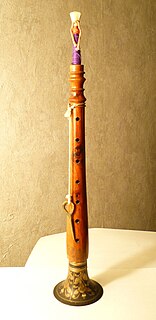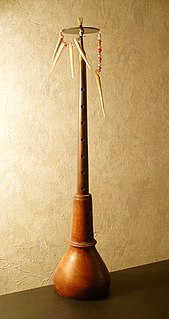
A reed is a thin strip of material that vibrates to produce a sound on a musical instrument. Most woodwind instrument reeds are made from Arundo donax or synthetic material. Tuned reeds are made of metal or synthetics. Musical instruments are classified according to the type and number of reeds.

Pooram pronounced [puːɾam] is an annual festival, which is celebrated in temples dedicated to goddesses Durga or Kali held especially in Valluvanadu area and other adjoining parts of north-central Kerala after the summer harvest. Harimattom pooram is the one of the famous pooram in Ernakulam. An example of a famous pooram is Thirumandhamkunnu Pooram which has an active participation of 11 Lakh people across the country. Most pooram festivals have at least one ornately decorated elephant being paraded in the procession taken out of the temple precincts. However, there are some well known poorams, such as Anthimahakalankavu Vela, Chelakkara, Aryankavu Pooram at shoranur Palakkad and Machad mamangam near Wadakkanchery that do not use the caparisoned elephant, instead go for stilted mannequins of horses or bullocks. Vela is also a festival like pooram. Thrissur Pooram is the most famous of all poorams, known for fire works .The second best known Pooram in Kerala is Uthralikavu Pooram. Kavassery pooram is well known for fireworks during afternoon. Some other well-known pooram festivals are Arattupuzha-Peruvanam Pooram,Chalissery Pooram, Anthimahakalankavu Vela, Nenmara Vallangi Vela, Chinakathoor pooram, Mannarkkad Pooram, Kavassery Pooram, Pariyanampatta Pooram, Harimattom Pooram and Thirumandhamkunnu Pooram,. Peruvanam-Arattupuza pooram is celebrating its 1436th year in 2018.

The nādasvaram, nāgasvaram, nātacuvaram, nātasvaram, nāgasvara, or variously spelled as nadaswaram, nadhaswaram, nagaswaram, nataswaram and nathaswaram, is a double reed wind instrument from South India. It is used as a traditional classical instrument in Tamilnadu, Andhra Pradesh, Karnataka, and Kerala.

The shehnai is a musical instrument, originating from the Indian subcontinent. It is made out of wood, with a double reed at one end and a metal or wooden flared bell at the other end. Its sound is thought to create and maintain a sense of auspiciousness and sanctity and as a result, is widely used during marriages, processions and in temples although it is also played in concerts. It was a part of the Naubat or traditional ensemble of nine instruments found in the royal court. The shehnai is similar to South India's nadaswaram.
The sralai is a Cambodian wind instrument that uses a quadruple reed to produce sound. The instrument is used in the pinpeat orchestra, where it is the only wind instrument. The set of quadruple reeds are made of palm leaf. The bore of the instrument is not evenly bored, but "slightly conical." Its cousin, the Western oboe, has a double reed and a conical bore. The pinpeat instruments tune to the sralai's pitch, and the player must learn circular breathing to play continuously without stopping for breath. The sralai is very similar in construction and playing technique to the Thai pi.

Panchavadyam, literally meaning an orchestra of five instruments, is basically a temple art form that has evolved in Kerala. Of the five instruments, four — timila, maddalam, ilathalam and idakka — belong to the percussion category, while the fifth, kombu, is a wind instrument.

Pandi melam is a classical percussion concert or melam (ensemble) led by the ethnic Kerala instrument called the chenda and accompanied by ilathalam (cymbals), kuzhal and Kombu.

Panchari Melam is a percussion ensemble, performed during temple festivals in Kerala, India. Panchari Melam, is one of the major forms of chenda melam, and is the best-known and most popular kshetram vadyam genre. Panchari melam, comprising instruments like chenda, ilathalam, kombu and kuzhal, is performed during virtually every temple festival in central Kerala, where it is arguably presented in the most classical manner. Panchari, however, is also traditionally performed, with a touch of subtle regional difference, in north (Malabar) and south-central Kerala (Kochi). Of late, its charm has led to its performance even in deep-south Kerala temples.
A melam is a type of percussion instrument that is unique to Tamil Nadu, Kerala and parts of South India. Those who plays melam are called 'Melakaar'. In ancient Tamilakam melam was used for all the occasions in temples, marriages, functions, funeral wake(Parai Melam). In Kerala the most traditional of all melams is the Pandi Melam, which is generally performed outside the temple. Another melam called the Panchari Melam, which is similar to Pandi Melam, but the Panchari Melam is played inside the temple.

The Chanda is a cylindrical percussion instrument originating in the state of Kerala and widely used in Tulu Nadu of Karnataka and Tamil Nadu in India. In Tulu Nadu, it is known as chende. It is greatly identified as a cultural element in Kerala and Tulu Nadu.

The maddalam or madhalam is a drum made out of the wood of the jackfruit tree. It has two sides for playing, made out of leather, and has different kind of sounds on each side. The maddalam is a heavy instrument which is hung around the waist of the person playing, and the player stands all the while to perform. The maddalam is a vital instrument in traditional Kerala percussion ensembles like Panchavadyam, Keli and Kathakali orchestra.

Elathalam, or Ilathalam, is a metallic musical instrument which resembles a miniature pair of cymbals. This instrument from Kerala and Tamil Nadu in southern India is completely made out of bronze and has two pieces in it.

Cherpu is a suburb of Thrissur city, in Kerala state in south India. It is 12 kilometres south of Thrissur town and is on the Thriprayar road. It is dotted by a number of temples and has quite a few rivers flowing by its vicinity.
Uthramvilakku is a temple festival celebrated at Edakkunni in Ollur, south of Thrissur in central Kerala, south India. The highlight of the event is an over four-hour Panchari melam in the temple compound past midnight on the uthram day, with each of the five caparisoned elephants on the occasion carrying a deity each from as many temples.

The kèn bầu is one of several types of kèn, a double reed wind instrument used in the traditional music of Vietnam. It is similar in construction and sound to the Chinese suona and the Korean taepyeongso. It comes in various sizes and is a primary instrument of the music of the former royal court music of Huế.
Kshetram vadyam is the ritual music of South India. This is the main traditional music of Kerala state. It is a percussion dominated music.

The urumi is a double-headed hourglass-shaped drum from the state of Tamil Nadu, South India. Two skin heads are attached to a single hollow, often intricately carved wooden shell. The preferred wood is jackwood, although other woods like rosewood may be used. Both left and right heads are usually made from cow hide that is stretched around a thin metal ring. The outer circumference of each head is perforated with approximately seven to eight holes. The two heads are held in tension by a continuous rope that is woven around the drum in a V-shape pattern. Additional small coils of string or metal are tied around each pair of ropes near the left head. These coils can be slide horizontally along the length of the drum, increasing or decreasing the tension between the heads as necessary. For example, during the monsoon season the drum heads will slacken so much that the instrument becomes unplayable. Using these coils drummers can easily rectify such problems.
Kuzhal pattu is a form of traditional temple music practised in the Kerala state of India. It centers on the use of the kuzhal, a double reed wind instrument, and is typically performed at temple festivals.

Kalampattu is a traditional performing art in Kerala, India.















